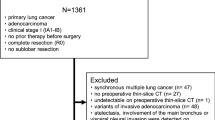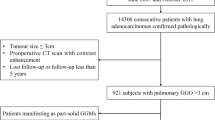Abstract
Purpose
We aimed to investigate the treatment effect of chemotherapy on ground-glass opacity (GGO)-featured lung adenocarcinoma radiologically and pathologically.
Methods
This retrospective study included patients who met the following criteria: (1) presence of lung GGO lesions before chemotherapy for other concurrent malignancies; (2) underwent surgical resection of GGO-featured primary lung adenocarcinoma. The last computed tomography images before chemotherapy (CT1) and the last images before GGO resection (CT2) were reviewed to assess radiologic response. Specimens of the resected tumors were reviewed to evaluate the histopathologic response. Immunohistochemical staining of ki-67, caspase-3 and β-gal was performed and compared between these tumors and a propensity score-matched (1:1) cohort of GGO-featured lung adenocarcinoma without prior chemotherapy.
Results
Forty-four patients with 55 GGO lesions were included. There were 20 mixed GGOs and 22 invasive adenocarcinomas. These patients all received at least three cycles of chemotherapy for other concurrent malignancies in breast, lung, cervix, ovary or rectum. Thirty-four (77%) patients received chemotherapy regimens that contained platinum, pemetrexed, paclitaxel, docetaxel or gemcitabine. The median interval between CT1 and CT2 was 10 months. Radiologically, all the GGO lesions either remained unchanged or enlarged. There was no chemotherapy-induced histopathologic response (necrosis, fibrosis or inflammation) in any of these tumors. The protein expression of ki-67, caspase-3 and β-gal was comparable between GGO-featured lung adenocarcinoma with or without prior chemotherapy.
Conclusion
GGO-featured lung adenocarcinoma has no response to chemotherapy. For these patients, chemotherapy should not be a treatment option.

Similar content being viewed by others
References
Chang J et al (1999) Biologic markers as predictors of clinical outcome from systemic therapy for primary operable breast cancer. J Clin Oncol 17:3058–3063. https://doi.org/10.1200/JCO.1999.17.10.3058
Demaria M et al (2017) Cellular senescence promotes adverse effects of chemotherapy and cancer relapse. Cancer Discov 7:165–176. https://doi.org/10.1158/2159-8290.CD-16-0241
Dooms C, Verbeken E, Stroobants S, Vansteenkiste J (2009) Biological correlates of the maximum 18-fluoro-2-deoxy-glucose uptake on positron emission tomography in non-small cell lung carcinoma after induction chemotherapy. J Thorac Oncol 4:1221–1225. https://doi.org/10.1097/JTO.0b013e3181ab0997
Eisenhauer EA et al (2009) New response evaluation criteria in solid tumours: revised RECIST guideline (version 1.1). Eur J Cancer 45:228–247. https://doi.org/10.1016/j.ejca.2008.10.026
Geeleher P, Cox NJ, Huang RS (2014) Clinical drug response can be predicted using baseline gene expression levels and in vitro drug sensitivity in cell lines. Genome Biol 15:R47. https://doi.org/10.1186/gb-2014-15-3-r47
Hansell DM, Bankier AA, MacMahon H, McLoud TC, Muller NL, Remy J (2008) Fleischner Society: glossary of terms for thoracic imaging. Radiology 246:697–722. https://doi.org/10.1148/radiol.2462070712
Junker K, Langner K, Klinke F, Bosse U, Thomas M (2001) Grading of tumor regression in non-small cell lung cancer: morphology and prognosis. Chest 120:1584–1591. https://doi.org/10.1378/chest.120.5.1584
Kobayashi Y, Mitsudomi T (2013) Management of ground-glass opacities: should all pulmonary lesions with ground-glass opacity be surgically resected? Transl Lung Cancer Res 2:354–363. https://doi.org/10.3978/j.issn.2218-6751.2013.09.03
Leek JT, Johnson WE, Parker HS, Jaffe AE, Storey JD (2012) The sva package for removing batch effects and other unwanted variation in high-throughput experiments. Bioinformatics 28:882–883. https://doi.org/10.1093/bioinformatics/bts034
Liu X, Jiang S, Tian X, Jiang Y (2018) Expression of cleaved caspase-3 predicts good chemotherapy response but poor survival for patients with advanced primary triple-negative breast cancer. Int J Clin Exp Pathol 11:4363–4373
Lu W, Cham MD, Qi L, Wang J, Tang W, Li X, Zhang J (2017) The impact of chemotherapy on persistent ground-glass nodules in patients with lung adenocarcinoma. J Thorac Dis 9:4743–4749. https://doi.org/10.21037/jtd.2017.10.50
Matsuguma H et al (2013) Characteristics of subsolid pulmonary nodules showing growth during follow-up with CT scanning. Chest 143:436–443. https://doi.org/10.1378/chest.11-3306
Morero JL, Poleri C, Martin C, Van Kooten M, Chacon R, Rosenberg M (2007) Influence of apoptosis and cell cycle regulator proteins on chemotherapy response and survival in stage IIIA/IIIB NSCLC patients. J Thorac Oncol 2:293–298. https://doi.org/10.1097/01.JTO.0000263711.54073.fa
Pataer A et al (2012) Histopathologic response criteria predict survival of patients with resected lung cancer after neoadjuvant chemotherapy. J Thorac Oncol 7:825–832. https://doi.org/10.1097/JTO.0b013e318247504a
Sasada S, Miyata Y, Mimae T, Mimura T, Okada M (2015) Impact of lepidic component occupancy on effects of adjuvant chemotherapy for lung adenocarcinoma. Ann Thorac Surg 100:2079–2086. https://doi.org/10.1016/j.athoracsur.2015.05.102
William WN Jr et al (2013) Computed tomography RECIST assessment of histopathologic response and prediction of survival in patients with resectable non-small-cell lung cancer after neoadjuvant chemotherapy. J Thorac Oncol 8:222–228. https://doi.org/10.1097/JTO.0b013e3182774108
Ye T et al (2018) Predictors of pathologic tumor invasion and prognosis for ground glass opacity featured lung adenocarcinoma. Ann Thorac Surg 106:1682–1690. https://doi.org/10.1016/j.athoracsur.2018.06.058
Zhang Y et al (2019) Results of low-dose computed tomography as a regular health examination among Chinese hospital employees. J Thorac Cardiovasc Surg. https://doi.org/10.1016/j.jtcvs.2019.10.145
Zhang Y et al (2019b) Results of low-dose computed tomography as a regular health examination among Chinese hospital employees. J Thorac Cardiovasc Surg. https://doi.org/10.1016/j.jtcvs.2019.10.145
Funding
This work was supported by the National Natural Science Foundation of China (81930073, 81772466, and 81972171), Shanghai Shenkang Hospital Development Center City Hospital Emerging Cutting-edge Technology Joint Research Project (SHDC12017102) and Shanghai Municipal Health Commission Key Discipline Project (2017ZZ02025 and 2017ZZ01019).
Author information
Corresponding author
Ethics declarations
Conflict of interest
The authors declare that they do have have any conflict of interest.
Additional information
Publisher's Note
Springer Nature remains neutral with regard to jurisdictional claims in published maps and institutional affiliations.
Electronic supplementary material
Below is the link to the electronic supplementary material.
432_2020_3234_MOESM1_ESM.tif
Supplementary figure1 Representative images of protein staining of ki-67, caspase-3 and β-gal in ground glass opacity featured lung adenocarcinoma with or without prior chemotherapy (TIF 2005 kb)
432_2020_3234_MOESM2_ESM.tif
Supplementary figure 2 Batch effects arising from two RNA-seq datasets (Fudan University Shanghai Cancer Center, FUSCC, blue; The Cancer Genome Atlas, TCGA, red) were successfully adjusted using principal components analysis (PCA). The first two principal components of the ComBat-transformed data which capture the most variance are shown. Furthermore, the PCA plot of samples adjusted for batch effects showed a clear separation between tumor (blue) and normal lung tissue samples (red) (TIF 503 kb)
432_2020_3234_MOESM3_ESM.tif
Supplementary figure 3 Ground glass opacity (GGO) featured lung adenocarcinoma had a significantly higher predicted half-maximal inhibitory concentration (IC50) for cisplatin, docetaxel, gemcitabine, vinorelbine and etoposide than solid lung adenocarcinoma. Prediction of chemotherapeutic response for each sample was based on the Genomics of Drug Sensitivity in Cancer (TIF 226 kb)
Rights and permissions
About this article
Cite this article
Zhang, Y., Deng, C., Ma, X. et al. Ground-glass opacity-featured lung adenocarcinoma has no response to chemotherapy. J Cancer Res Clin Oncol 146, 2411–2417 (2020). https://doi.org/10.1007/s00432-020-03234-6
Received:
Accepted:
Published:
Issue Date:
DOI: https://doi.org/10.1007/s00432-020-03234-6




